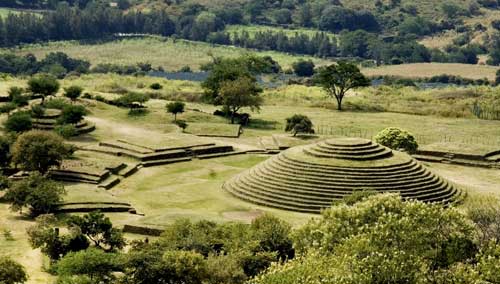Book Review: TradiciónTeuchitlán
Landmark publication on Teuchitlán Tradition defies old archeological assumptions

TradiciónTeuchitlán / Phil C. Weigand, Christopher Beekman, Rodrigo Esparza,
editors. – Zamora, Mich. : El Colegio de Michoacán: Secretaría de Cultura del
Estado de Jalisco, 2008. 334 p.: il + gráficos; 23 cm – Colección Occidente).
Curiously, it was the Colegio de Michoacán which encouraged and backed
archeological studies in the neighboring state of Jalisco, eventually leading to
the discovery of a complex civilization which once dominated western Mexico.
Now, in celebration of the Colegio’s 30th anniversary, comes the publication of
a major compendium of papers by 13 international experts in the archeology of
what has been called the Teuchitlán Tradition. The arguments of these authors
are so overwhelming that future publications will likely refer to the builders
of the Guachimontones as “The Teuchitlán Civilization.”
This 345-page, soft-cover book, entitled TradiciónTeuchitlán and jointly
published by the Colegio de Michoacán and the Jalisco Secretariat of Culture, is
written entirely in Spanish and lists Phil C. Weigand, Christopher Beekman and
Rodrigo Esparza as editors. It includes 95 figures.
|
The Foreword to this book is fascinating. Eduardo Williams of the Colegio de
Michoacán summarizes the long and difficult struggle which Weigand and his
associates went through to present their discoveries to the proponents of the
“official Mexican archeological establishment” who steadfastly held that western
Mexico was of little importance in the study of Mesoamerican archeology. “It
was,” states Williams, “as if the archeologists in the west were looking through
a one-way mirror. They could see their colleagues on the other side, but those
colleagues could not see them.”
|
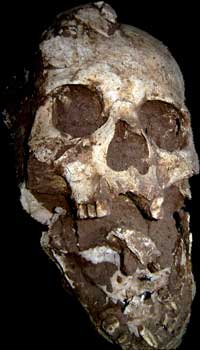 |
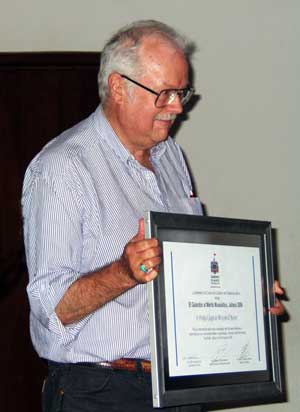 In the first chapter, Phil Weigand describes the excavations of ten concentric
circular structures (locally known as Guachimontones) located just above the
town of Teuchitlán, 40 kilometers west of Guadalajara. These structures cover an
area of 20 hectares and surround a ball court 111 meters long which, for 1000
years, was the biggest in all Mesoamerica. Weigand began investigating this area
in 1970 but the excavations only took place between 1999 and 2005. During this
period, offerings, figurines, shaft tombs and burials were found, as well as
evidence that the monuments were originally plastered and painted and that a
pole for volador (Flying Bird Man) ceremonies was typically set at the top of
each pyramid. So much was found that Weigand must have found it difficult to
summarize it all in 26 pages.
In the first chapter, Phil Weigand describes the excavations of ten concentric
circular structures (locally known as Guachimontones) located just above the
town of Teuchitlán, 40 kilometers west of Guadalajara. These structures cover an
area of 20 hectares and surround a ball court 111 meters long which, for 1000
years, was the biggest in all Mesoamerica. Weigand began investigating this area
in 1970 but the excavations only took place between 1999 and 2005. During this
period, offerings, figurines, shaft tombs and burials were found, as well as
evidence that the monuments were originally plastered and painted and that a
pole for volador (Flying Bird Man) ceremonies was typically set at the top of
each pyramid. So much was found that Weigand must have found it difficult to
summarize it all in 26 pages.
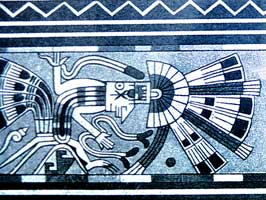 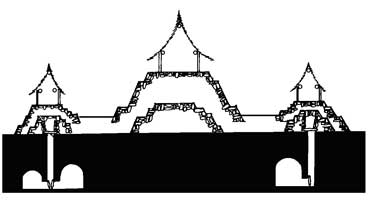 Left:
"Teuchitlán, place of the first god" depicted
on a clay vessel Left:
"Teuchitlán, place of the first god" depicted
on a clay vesselRight: Profile showing a circular pyramid, platforms and tombs (sketch by Phil Weigand) |
Several contributors to this volume examine and group the large number of
monumental circles of western Mexico in an attempt to understand them in terms
of influence and manpower. Another study focuses on the social significance of
banquets and fiestas held at the circles by examining the types and numbers of
ceramic containers used for holding food and drink. In addition, there is a
quite different article on the wanton destruction of various important
archeological sites in the valleys around Tequila Volcano by members of the
tequila industry. This is tragic and ironic in light of the U.N.’s decision to
declare this area a World Heritage Site, simultaneously honoring the
archeological ruins and the tequila business.
|
In the final chapter, Beekman and Weigand bring together chronological evidence
based on artifacts and radiocarbon dates and suggest how this data might best be
organized. They propose a new synthesis, which follows the Teuchitlán tradition
from the middle Formative period to the middle Classical.
|
 |
